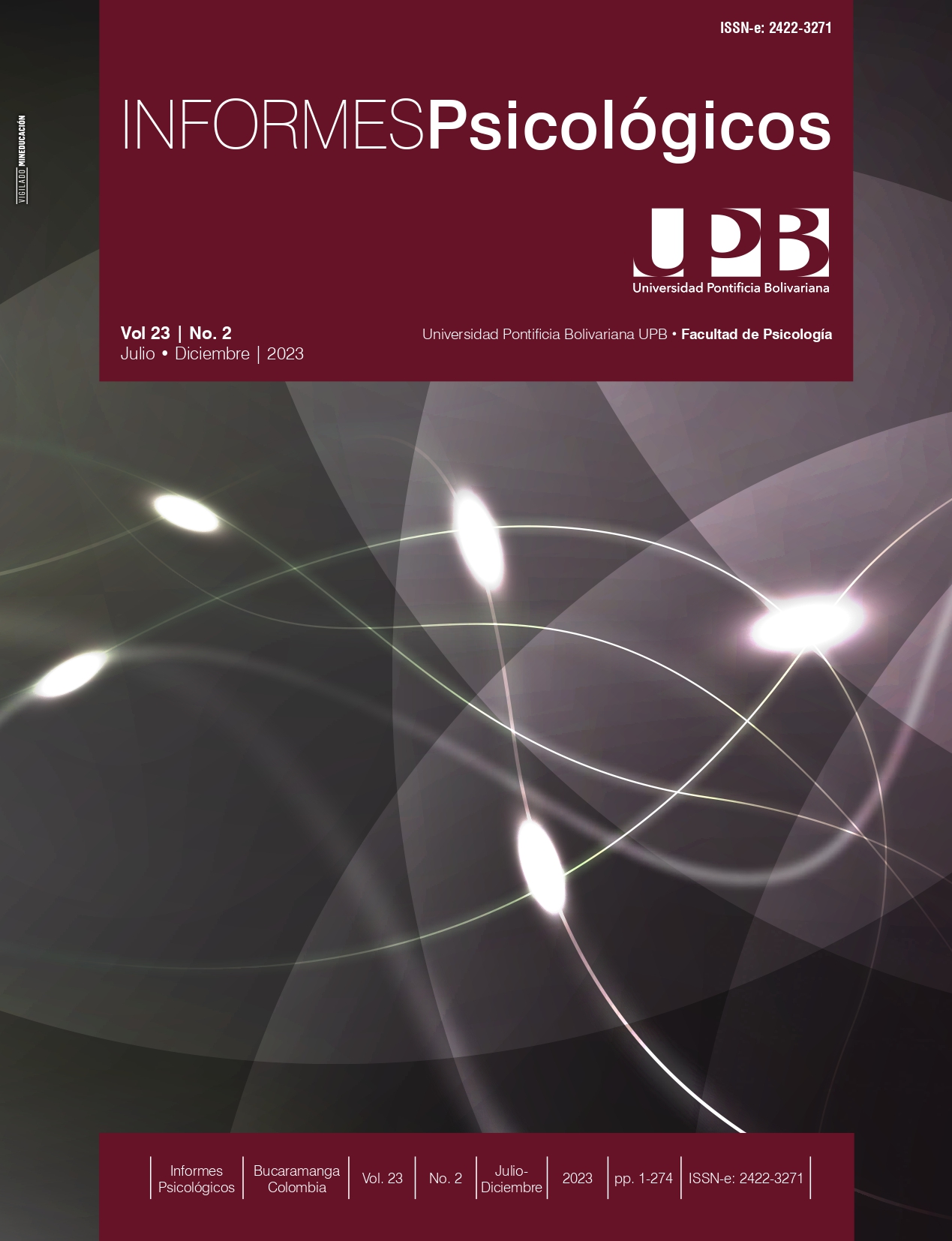Errores del control cognitivo en la supresión de las actitudes hostiles implícitas
Contenido principal del artículo
Resumen
Interpretar sesgadamente situaciones neutrales como potencialmente hostiles puede facilitar la agresión. Investigaciones sugieren que las interpretaciones sesgadas ocurren automática e implícitamente. Esta investigación busca establecer si un entrenamiento en las funciones ejecutivas reduce las atribuciones hostiles implícitas. Las funciones ejecutivas describen procesos asociados con control, planeación y asignación de recursos atencionales para desempeñar acciones dirigidas a metas. Una muestra de noventa y ocho estudiantes universitarios fue distribuida aleatoriamente a dos grupos expuestos a versiones modificadas del Test de Asociaciones Implícitas (IAT), para evaluar los niveles de atribuciones hostiles automáticas. El grupo experimental fue entrenado mediante la Tarea de Stroop, mientras que el grupo de control se expuso a una tarea neutral. Aunque los resultados no confirmaron la hipótesis de trabajo, los resultados muestran que el IAT puede ser efectivamente adaptado para medir las actitudes implícitas agresivas. En conjunto, esta metodología puede contribuir a dilucidar la influencia de factores sociales versus factores cognitivos en la generación de violencia.
Citas
Acemoglu, D., Robinson, J., & Santos, R. (2009). The Monopoly of Violence: Evidence from Colombia. National Bureau of Economic Research. http://www.nber.org/papers/w15578.pdf
Anderson, C. A., & Bushman, B. J. (2002). Human Aggression. Annual Review of Psychology, 53(1), 27-51. http://doi.org/10.1146/annurev.psych.53.100901.135231
Barratt, E. S. (1965). Factor analysis of some psychometric measures of impulsiveness and anxiety. Psychological Reports, 16(2), 547-554. https://doi.org/10.2466/pr0.1965.16.2.547
Bandura, A. (2001). Social Cognitive Theory: An Agentic Perspective. Annual Review of Psychology, 52(1), 1-26. http://doi.org/10.1146/annurev.psych.52.1.1
Bluemke, M., Crombach, A., Hecker, T., Schalinski, I., Elbert, T., & Weierstall, R. (2017). Is the Implicit Association Test for Aggressive Attitudes a Measure for Attraction to Violence or Traumatization? Zeitschrift Für Psychologie, 225(1), 54-63. https://doi.org/10.1027/2151-2604/a000281
Bluemke, M., & Teige-Mocigemba, S. (2014). Automatic processes in aggression: Conceptual and assessment issues: Automatic Processes in Aggression. Aggressive Behavior 41(1), 44-50. http://doi.org/10.1002/AB.21576
Buss, A. H., & Perry, M. (1992). The Aggression Questionnaire. Journal of Personality and Social Psychology, 63(3), 452-459. http://doi.org/10.1037/0022-3514.63.3.452
Castrillón, D. A., Ortiz, P., y Vieco, F. (2004). Cualidades paramétricas del Cuestionario de Agresión (AQ) de Buss y Perry en estudiantes universitarios de la ciudad de Medellín (Colombia). Revista Facultad Nacional de Salud Pública, 22(2), 49-61. https://dialnet.unirioja.es/descarga/articulo/5079687.pdf
Chahín-Pinzón, N. (2013). Adaptación de dos instrumentos para niños colombianos: la escala Barratt de impulsividad (BIS-11C) y el cuestionario de agresividad de Buss y Perri (AQ) [Tesis de doctorado, Universitat Rovira i Virgili]. https://repositori.urv.cat/estatic/TDX0011/es_TDX1283.html
Chahín-Pinzón, N., Lorenzo-Seva, U., & Vigil-Colet, A. (2012). Características psicométricas de la adaptación colombiana del Cuestionario de Agresividad de Buss y Perry en una muestra de preadolescentes y adolescentes de Bucaramanga. Universitas Psychologica, 11(3), 979-988. http://www.redalyc.org/articulo.oa?id=64724634025
Dodge, K., Bates, J., & Pettit, G. (1990). Mechanisms in the cycle of violence. Science, 250(4988), 1678-1683. http://doi.org/10.1126/science.2270481
Gray, N. S., MacCulloch, M. J., Smith, J., Morris, M., & Snowden, R. J. (2003). Forensic psychology: Violence viewed by psychopathic murderers. Nature, 423, 497-498. http://doi.org/10.1038/423497a
Greenwald, A. G., McGhee, D. E., & Schwartz, J. L. K. (1998). Measuring individual differences in implicit cognition: The implicit association test. Journal of Personality and Social Psychology, 74(6), 1464-1480. https://doi.org/10.1037/0022-3514.74.6.1464
Greenwald, A. G., & Banaji, M. R. (1995). Implicit social cognition: Attitudes, self-esteem, and stereotypes. Psychological Review, 102(1), 4-27. http://doi.org/10.1037/0033-295X.102.1.4
Ila, A. B., & Polich, J. (1999). P300 and response time from a manual Stroop task. Clinical Neurophysiology, 110(2), 367-373. http://doi.org/10.1016/S0168-5597(98)00053-7
Jimeno, M. (2001). Violence and Social Life in Colombia. Critique of Anthropology, 21(3), 221-246. http://doi.org/10.1177/0308275X0102100302
Lang, P., Bradley, M., & Cuthbert, B. (2008). International affective picture system (IAPS): Affective ratings of pictures and instruction manual. University of Florida.
MacLeod, C. M. (1991). Half a century of research on the Stroop effect: An integrative review. Psychological Bulletin, 109(2), 163-203. http://doi.org/10.1037/0033-2909.109.2.163
Madera-Carrillo, H., Zarabozo, D., Ruiz-Díaz, M., & Berriel-Saez, P. (2015). El Sistema Internacional de Imágenes Afectivas (IAPS) en población mexicana [Reporte técnico, Universidad de Guadalajara].
Nosek, B. A., Greenwald, A. G., & Banaji, M. R. (2007). The Implicit Association Test at age 7: A methodological and conceptual review. En E. J. A. Bargh (Ed.), Frontiers of social psychology. Social psychology and the unconscious: The automaticity of higher mental processes (pp. 265-292). Psychology Press. https://doi.org/10.1037/t61436-000
Olivera-La Rosa, A., Villacampa, J., Amador, O., Corradi, G., Munar, E., Acosta, S., & Rosselló, J. (2021). Implicit attitudes toward violence in a sample of adolescent offenders with conduct disorder. Journal of Interpersonal Violence, 36(1-2), 1050-1063. https://doi.org/10.1177/0886260517739287
Parra, J. A., & Tamayo, R. M. (2021). Medidas implícitas en cognición: una aproximación al estudio de la automaticidad. Revista Colombiana de Psicología, 30(1), 89-110. https://doi.org/10.15446/rcp.v30n1.85106
Patton, J. H., Stanford, M. S., & Barratt, E. S. (1995). Factor structure of the Barratt impulsiveness scale. Journal of Clinical Psychology, 51(6), 768-774. https://doi.org/10.1002/1097-4679(199511)51:6
Posner, M. I., & Petersen, S. E. (1990). The attention system of the human brain. Annual Review of Neuroscience, 13, 25-42 https://doi.org/10.1146/annurev.ne.13.030190.000325
Redondo, J., Fraga, I., Comesaña, M., & Perea, M. (2005). Estudio normativo del valor afectivo de 478 palabras españolas. Psicológica, 26(2), 317-326. http://www.redalyc.org/articulo.oa?id=16926207
Redondo, J., Fraga, I., Padrón, I., & Comesaña, M. (2007). The Spanish adaptation of ANEW (Affective Norms for English Words). Behavior Research Methods, 39(3), 600- 605. http://doi.org/10.3758/BF03193031
Stanford, M. S., Mathias, C. W., Dougherty, D. M., Lake, S. L., Anderson, N. E., & Patton, J. H. (2009). Fifty years of the Barratt Impulsiveness Scale: An update and review. Personality and Individual Differences, 47(5), 385-395. http://doi.org/10.1016/j.paid.2009.04.008
Stroop, J. R. (1935). Studies of interference in serial verbal reactions. Journal of Experimental Psychology, 18(6), 643-662. http://doi.org/10.1037/h0054651
Uribe, M. V. (2004). Anthropologie de l’inhumanité: essai sur la terreur en Colombie. Calmann-Lévy. https://doi.org/10.4000/chs.333
Waldmann, P. (2007). Is There a Culture of Violence in Colombia? International Journal of Conflict and Violence, 1(1), 61-75. https://doi.org/10.1080/09546550701626836


